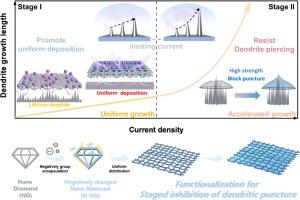Staged dendrite suppression for high safe and stable lithium-sulfur batteries
IF 13.1
1区 化学
Q1 Energy
引用次数: 0
Abstract
The unavoidable dendrite growth and shuttle effect have long been stranglehold challenges limiting the safety and practicality of lithium-sulfur batteries. Herein, we propose a dual-action strategy to address the lithium dendrite issue in stages by constructing a multifunctional surface-negatively-charged nanodiamond layer with high ductility and robust puncture resistance on polypropylene (PP) separator. The uniformly loaded compact negative layer can not only significantly enhance electron transmission efficiency and promote uniform lithium deposition, but also reduce the formation of dendrite during early deposition stage. Most importantly, under the strong puncture stress encountered during the deterioration of lithium dendrite growth under limiting current, the high ductility and robust puncture resistance (145.88 MPa) of as-obtained nanodiamond layer can effectively prevent short circuits caused by unavoidable lithium dendrite. The Li||Li symmetrical cells assembled with nanodiamond layer modified PP demonstrated a stable cycle of over 1000 h at 2 mA cm−2 with a polarization voltage of only 29.3 mV. Additionally, the negative charged layer serves as a physical barrier blocking lithium polysulfide ions, effectively mitigating capacity attenuation. The improved cells achieved a capacity decay of only 0.042% per cycle after 700 cycles at 3 C, demonstrating effective suppression of dendrite growth and capacity attenuation, showing promising prospect.

分阶段抑制枝晶,实现安全稳定的锂硫电池
长期以来,不可避免的枝晶生长和穿梭效应一直是制约锂硫电池安全性和实用性的难题。在此,我们提出了一种双效策略,通过在聚丙烯(PP)隔膜上构建具有高延展性和强抗穿刺性的多功能表面负电荷纳米金刚石层,分阶段解决锂枝晶问题。均匀负载的致密负电层不仅能显著提高电子传输效率,促进锂的均匀沉积,还能减少沉积初期枝晶的形成。最重要的是,在限流条件下,锂枝晶生长恶化过程中会遇到强大的穿刺应力,而纳米金刚石层具有高延展性和强大的抗穿刺能力(145.88 兆帕),可有效防止不可避免的锂枝晶造成的短路。用纳米金刚石层改性聚丙烯组装的锂||锂对称电池在 2 mA cm-2 的条件下可稳定循环 1000 小时以上,极化电压仅为 29.3 mV。此外,带负电的层还起到了阻挡多硫化锂离子的物理屏障作用,有效缓解了容量衰减。改进后的电池在 3 C 下循环 700 次后,每次循环的容量衰减仅为 0.042%,这表明树枝状突起的生长和容量衰减得到了有效抑制,前景十分广阔。
本文章由计算机程序翻译,如有差异,请以英文原文为准。
求助全文
约1分钟内获得全文
求助全文
来源期刊

Journal of Energy Chemistry
CHEMISTRY, APPLIED-CHEMISTRY, PHYSICAL
CiteScore
19.10
自引率
8.40%
发文量
3631
审稿时长
15 days
期刊介绍:
The Journal of Energy Chemistry, the official publication of Science Press and the Dalian Institute of Chemical Physics, Chinese Academy of Sciences, serves as a platform for reporting creative research and innovative applications in energy chemistry. It mainly reports on creative researches and innovative applications of chemical conversions of fossil energy, carbon dioxide, electrochemical energy and hydrogen energy, as well as the conversions of biomass and solar energy related with chemical issues to promote academic exchanges in the field of energy chemistry and to accelerate the exploration, research and development of energy science and technologies.
This journal focuses on original research papers covering various topics within energy chemistry worldwide, including:
Optimized utilization of fossil energy
Hydrogen energy
Conversion and storage of electrochemical energy
Capture, storage, and chemical conversion of carbon dioxide
Materials and nanotechnologies for energy conversion and storage
Chemistry in biomass conversion
Chemistry in the utilization of solar energy
 求助内容:
求助内容: 应助结果提醒方式:
应助结果提醒方式:


